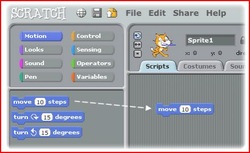In one of the conference keynotes during July 2012, Karen Brenan mentioned that Scratch was designed with informal learning environments in mind. Out of school computer clubs and that sort of thing. When I first had the idea of using it in 2009, there was no obvious unit of work into which it would fit. The best I could find was the 'Control and Modelling' unit which was often done with Logo (also developed at MIT by Seymour Papert) and the Lego Mindstorms robotics kit. This is how I would justify my first use of Scratch.

We all have to start somewhere!
So one day in May 2009, we downloaded Scratch 1.3 and installed it on to the computers in the computer suite. There would be one computer for each pair of students. I hadn't used it a great deal myself at this point but, armed with the Getting Started Guide and the Scratch Cards, we plunged in. I was enthusiastic and the students picked up on this, and responded with more than their usual enthusiasm.
We began by trying to get things moving. Still a good place to start. Even at the early stages of this first lesson, it was clear that the class were engaged. And that they wanted to go further than I had planned. They soon discovered the sprite editor. They soon discovered they could add backgrounds. And extra sprites. And then someone found the sound blocks...
Which brings me on to the main thread which will run through this discussion on the use of Scratch in school: how much of it should be structured teaching with scaffolding and support, and how much of it should be open-ended?
As I mentioned at the start, Scratch was designed with informal learning environments in mind - perhaps leaning more to the open-ended approach. The students in my first lesson quickly began open-ended investigations into how these new blocks worked. I am glad now that I had the confidence to let them do this. I've observed similar behaviour in lunchtime Scratch clubs, which can have a more laid-back approach. Sometimes though, they reach a plateau and begin producing lots of the same type of projects - the same level of projects. They stop trying new things. Do they need more support?
This is where the school structure can come in. School provides the ideal environment for moving students forward. Someone saying' "Why don't you... ?"
However this can easily lead to too much scaffolding, with children being led too much, often leading to many very similar projects with little of the student's ideas or creativity in them.
However this can easily lead to too much scaffolding, with children being led too much, often leading to many very similar projects with little of the student's ideas or creativity in them.
A balance is needed and can be struck. Three years of experience, from one extreme to the other, have allowed me to see both sides of the debate. The lesson plans and ideas to follow are my best effort to make a bridge between what I think of as the ethos, or spirit, of Scratch, and the structure of school.














